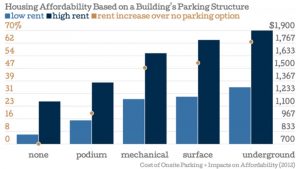Real estate in California is at a premium. Most of the land in the metropolitan areas and job centers have been developed. With most of the major cities along the coast, it also limits how much land can be developed east, as eventually, all housing would be too far from job centers. Parking takes up a large amount of the developed land in the state, in part because of minimum parking requirements by the state and local governments. AB 1401 would aim to reduce the parking minimums and also eliminate parking requirements for certain properties.
What does AB 1401 do?
If AB 1401 is signed into law, it would prevent local governments from requiring parking minimums on commercial, residential, and other lots if they are within a half mile, or walk-able distance of a major public transit stop. It would also apply to neighborhoods with a low VMT (vehicle miles traveled) area as defined by the office of planning and research. This means areas with walk-able communities where people don’t drive much won’t have parking minimums. The focus of the bill would be to allow housing to be built while keeping construction costs down by not requiring parking spots.
The cost of parking spots
Parking spots are expensive and they drive up construction costs. Even if nobody needs the parking spot, it is still required and can cost anywhere from 20k dollars for just a normal paved parking spot, all the way up to 80k dollars for a spot in a parking garage. Parking spots can increase the cost by up to 17% depending on the type of building.

Will people rent without parking spots?
There’s really no way of knowing how many people would be willing to rent a unit without off street parking. In California, the parking minimums means the market has never been able to decide. In Los Angeles County there’s two parking spots for each resident, but 7.5 percent of households in the county don’t even own a car.
We also don’t know what kinds of decisions residents will make when given the option between paying less in rent and taking public transit as opposed to paying more and owning a car. These decisions get made all the time when it comes to how many bedrooms, bathrooms, certain appliances etc are in the unit. It’s reasonable to think if people are given the option, they may choose the unit without parking.
Why parking minimums limit multifamily properties
Even if local laws allow for a certain number of units as well as the required square footage for those units, the parking minimums might actually make building the maximum number of units on a lot impossible. For example, if someone wanted to build an ADU and a junior ADU on their property, but the only way to do that meant using some parking spaces, it would not be possible. By removing parking minimums, those spaces now become useful real estate for building more units.
This would also apply to a multifamily apartment building. A ten unit apartment complex could fit on a lot that is zoned for multifamily, but if it requires one spot for each unit or per bedroom, that complex can’t be built.
Commentary
Until recently, I always owned a car. Since my 16th birthday, a car was a part of my life. Not long after I started working from home a few years ago, I was rear ended and my car was totaled. At the same time, my landlord decided to start charging for parking. I live in a walk-able neighborhood, and I was driving my car maybe once every 10 days. At this point, I could no longer justify the cost of owning a car. With remote jobs becoming increasingly common, the demand for a car and off street parking could decrease.

